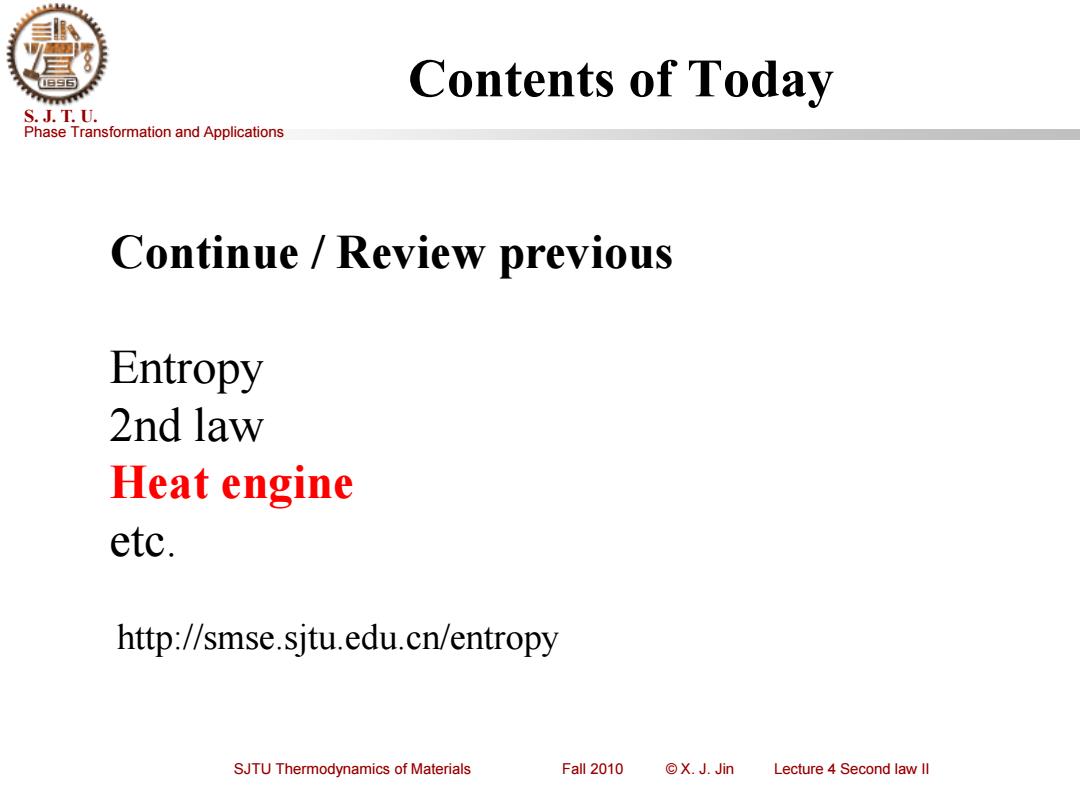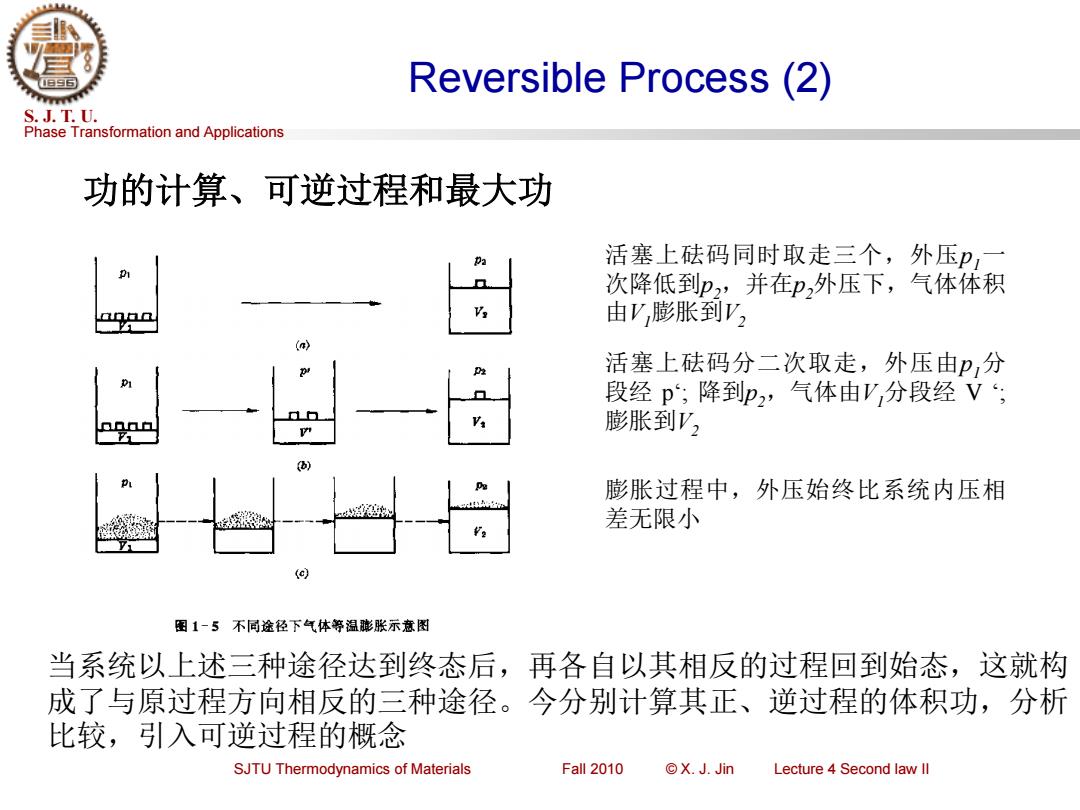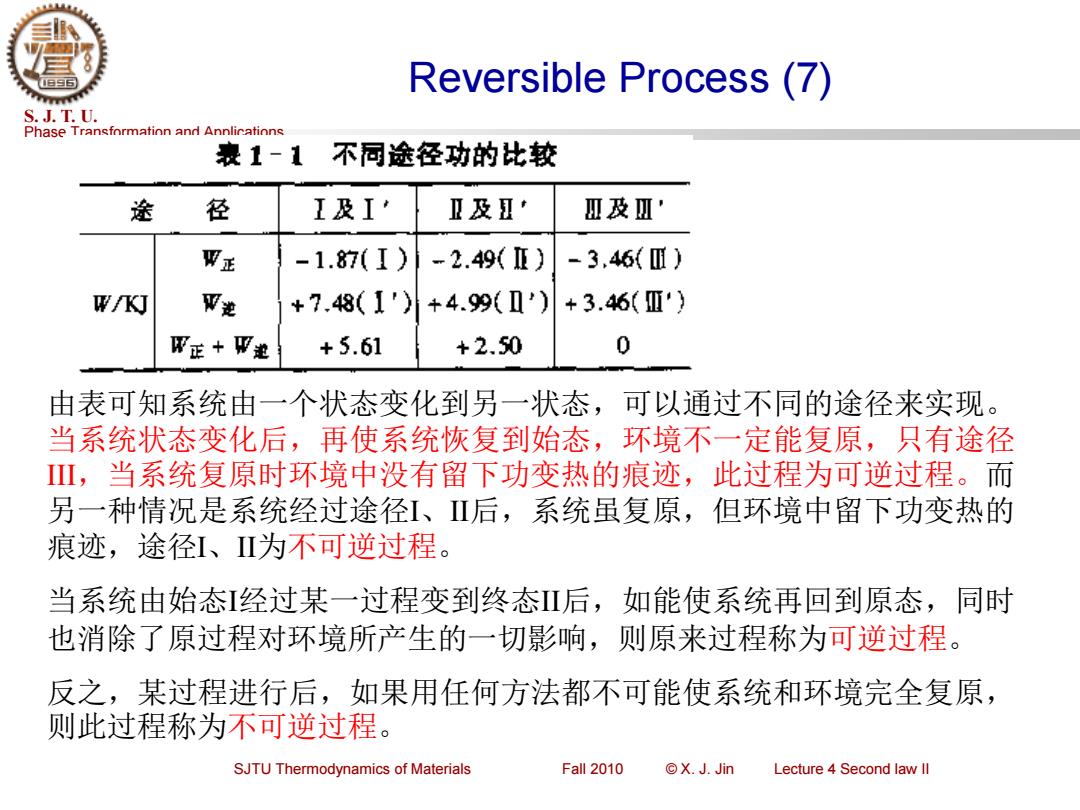
Contents of Today S.J.T.U. Phase Transformation and Applications Continue /Review previous Entropy 2nd law Heat engine etc. http://smse.sjtu.edu.cn/entropy SJTU Thermodynamics of Materials Fall 2010 ©X.J.Jin Lecture 4 Second law ll
Phase Transformation and Applications S. J. T. U. SJTU Thermodynamics of Materials Fall 2010 © X. J. Jin Lecture 4 Second law II Contents of Today Continue / Review previous Entropy 2nd law Heat engine etc. http://smse.sjtu.edu.cn/entropy

Reversible Process(2) S.J.T.U. Phase Transformation and Applications 功的计算、可逆过程和最大功 活塞上砝码同时取走三个,外压P,一 次降低到p2,并在p,外压下,气体体积 anag 19 由V,膨胀到V, 活塞上砝码分二次取走,外压由P,分 段经p;降到p2,气体由'分段经V‘; 膨胀到V, 膨胀过程中,外压始终比系统内压相 语 差无限小 (c) 图1-5不同途径下气体等温膨胀示意图 当系统以上述三种途径达到终态后,再各自以其相反的过程回到始态,这就构 成了与原过程方向相反的三种途径。今分别计算其正、逆过程的体积功,分析 比较,引入可逆过程的概念 SJTU Thermodynamics of Materials Fall 2010 ©X.J.Jin Lecture 4 Second law ll
Phase Transformation and Applications S. J. T. U. SJTU Thermodynamics of Materials Fall 2010 © X. J. Jin Lecture 4 Second law II Reversible Process (2) 功的计算、可逆过程和最大功 活塞上砝码同时取走三个,外压p1一 次降低到p2,并在p2外压下,气体体积 由V1膨胀到V2 活塞上砝码分二次取走,外压由p1分 段经 p‘; 降到p2,气体由V1分段经 V ‘; 膨胀到V2 膨胀过程中,外压始终比系统内压相 差无限小 当系统以上述三种途径达到终态后,再各自以其相反的过程回到始态,这就构 成了与原过程方向相反的三种途径。今分别计算其正、逆过程的体积功,分析 比较,引入可逆过程的概念

Reversible Process (7) S.J.T.U. Phase Transformation and Annlications 表1-1不同途径功的比较 途 径 I及I 亚及I Ⅲ及四' W正 -1.87(I) -2.49正) -3,46() W/KJ W逆 +7.48(1)+4.99Ⅱ) +3.46(Ⅲ') W正+W递 +5.61 +2.50 0 由表可知系统由一个状态变化到另一状态,可以通过不同的途径来实现。 当系统状态变化后,再使系统恢复到始态,环境不一定能复原,只有途径 Ⅲ,当系统复原时环境中没有留下功变热的痕迹,此过程为可逆过程。而 另一种情况是系统经过途径、Ⅱ后,系统虽复原,但环境中留下功变热的 痕迹,途径I、Ⅱ为不可逆过程。 当系统由始态经过某一过程变到终态Ⅱ后,如能使系统再回到原态,同时 也消除了原过程对环境所产生的一切影响,则原来过程称为可逆过程。 反之,某过程进行后,如果用任何方法都不可能使系统和环境完全复原, 则此过程称为不可逆过程。 SJTU Thermodynamics of Materials Fall 2010 ©X.J.Jin Lecture 4 Second law ll
Phase Transformation and Applications S. J. T. U. SJTU Thermodynamics of Materials Fall 2010 © X. J. Jin Lecture 4 Second law II Reversible Process (7) 由表可知系统由一个状态变化到另一状态,可以通过不同的途径来实现。 当系统状态变化后,再使系统恢复到始态,环境不一定能复原,只有途径 III,当系统复原时环境中没有留下功变热的痕迹,此过程为可逆过程。而 另一种情况是系统经过途径I、II后,系统虽复原,但环境中留下功变热的 痕迹,途径I、II为不可逆过程。 当系统由始态I经过某一过程变到终态II后,如能使系统再回到原态,同时 也消除了原过程对环境所产生的一切影响,则原来过程称为可逆过程。 反之,某过程进行后,如果用任何方法都不可能使系统和环境完全复原, 则此过程称为不可逆过程

Heat Engine S.J.T.U. Phase Transformation and Applications A D D B B C Pressure B C Volume SJTU Thermodynamics of Materials Fall 2010 ©X.J.Jin Lecture 4 Second law ll
Phase Transformation and Applications S. J. T. U. SJTU Thermodynamics of Materials Fall 2010 © X. J. Jin Lecture 4 Second law II Heat Engine

Carnot cycle(8) S.J.T.U. Phase Transformation and Applications Isothermal Adiabatic Isothermal Adiabatic A->B B->C C->D D->A ∑ C(T-T2)<0 W -R,n5<0 Vy7 RTln Vs C(T2-T)>0 R(T-T2)I V2.0 V 9 RT2 In V2,0 V320 R(T-T) △U 0 Cr(T-T2)<0 0 C(-T)>0 0 +9 =0 y Va L T SJTU Thermodynamics of Materials Fall 2010 ©X.J.Jin Lecture 4 Second law ll
Phase Transformation and Applications S. J. T. U. SJTU Thermodynamics of Materials Fall 2010 © X. J. Jin Lecture 4 Second law II Carnot cycle (8) W ln 0 3 4 1 V V Q ln 0 RT 1 2 2 V V RT ln 0 1 2 − 2 V V RT U 0 A->B B->C C->D D->A 0 Isothermal Adiabatic Isothermal Adiabatic ln 0 3 4 − 1 V V RT 0 0 ( ) 0 CV T1 −T2 ( ) 0 CV T2 −T1 ( ) 0 CV T1 −T2 ( ) 0 CV T2 −T1 0 ( )ln 0 1 2 1 − 2 V V R T T ( )ln 0 1 2 2 − 1 V V R T T Q2 Q1 0 1 1 2 2 + = T Q T Q 4 3 1 2 V V V V =